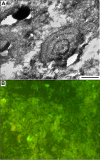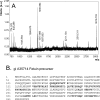Nanobacteria are mineralo fetuin complexes
- PMID: 18282102
- PMCID: PMC2242841
- DOI: 10.1371/journal.ppat.0040041
Nanobacteria are mineralo fetuin complexes
Abstract
"Nanobacteria" are nanometer-scale spherical and ovoid particles which have spurred one of the biggest controversies in modern microbiology. Their biological nature has been severely challenged by both geologists and microbiologists, with opinions ranging from considering them crystal structures to new life forms. Although the nature of these autonomously replicating particles is still under debate, their role in several calcification-related diseases has been reported. In order to gain better insights on this calciferous agent, we performed a large-scale project, including the analysis of "nanobacteria" susceptibility to physical and chemical compounds as well as the comprehensive nucleotide, biochemical, proteomic, and antigenic analysis of these particles. Our results definitively ruled out the existence of "nanobacteria" as living organisms and pointed out the paradoxical role of fetuin (an anti-mineralization protein) in the formation of these self-propagating mineral complexes which we propose to call "nanons." The presence of fetuin within renal calculi was also evidenced, suggesting its role as a hydroxyapatite nucleating factor.
Conflict of interest statement
Figures






Similar articles
-
Nanobacteria: an alternative mechanism for pathogenic intra- and extracellular calcification and stone formation.Proc Natl Acad Sci U S A. 1998 Jul 7;95(14):8274-9. doi: 10.1073/pnas.95.14.8274. Proc Natl Acad Sci U S A. 1998. PMID: 9653177 Free PMC article.
-
Fetuin is the key for nanon self-propagation.Microb Pathog. 2014 Aug;73:25-30. doi: 10.1016/j.micpath.2014.05.003. Epub 2014 May 24. Microb Pathog. 2014. PMID: 24862969
-
Potential role of calcifying nanoparticles in the etiology of multiple sclerosis.Med Hypotheses. 2019 Jul;128:25-27. doi: 10.1016/j.mehy.2019.05.005. Epub 2019 May 11. Med Hypotheses. 2019. PMID: 31203904
-
[Nanobacteria--microbiological characteristics].Postepy Hig Med Dosw (Online). 2004 Mar 3;58:60-4. Postepy Hig Med Dosw (Online). 2004. PMID: 15069381 Review. Polish.
-
The role of calcifying nanoparticles in biology and medicine.Int J Nanomedicine. 2012;7:339-50. doi: 10.2147/IJN.S28069. Epub 2012 Jan 19. Int J Nanomedicine. 2012. PMID: 22287843 Free PMC article. Review.
Cited by
-
Decreased nanobacteria levels and symptoms of nanobacteria-associated interstitial cystitis/painful bladder syndrome after tetracycline treatment.Int Urogynecol J. 2010 Jan;21(1):103-9. doi: 10.1007/s00192-009-0994-7. Epub 2009 Sep 17. Int Urogynecol J. 2010. PMID: 19760079
-
Membrane vesicles nucleate mineralo-organic nanoparticles and induce carbonate apatite precipitation in human body fluids.J Biol Chem. 2013 Oct 18;288(42):30571-30584. doi: 10.1074/jbc.M113.492157. Epub 2013 Aug 29. J Biol Chem. 2013. PMID: 23990473 Free PMC article. Clinical Trial.
-
Systemic injection of planktonic forms of mammalian-derived nanoparticles alters arterial response to injury in rabbits.Am J Physiol Heart Circ Physiol. 2009 May;296(5):H1434-41. doi: 10.1152/ajpheart.00993.2008. Epub 2009 Mar 13. Am J Physiol Heart Circ Physiol. 2009. PMID: 19286948 Free PMC article.
-
Characterization of granulations of calcium and apatite in serum as pleomorphic mineralo-protein complexes and as precursors of putative nanobacteria.PLoS One. 2009;4(5):e5421. doi: 10.1371/journal.pone.0005421. Epub 2009 May 1. PLoS One. 2009. PMID: 19412552 Free PMC article.
-
Calcium-based nanoparticles accelerate skin wound healing.PLoS One. 2011;6(11):e27106. doi: 10.1371/journal.pone.0027106. Epub 2011 Nov 2. PLoS One. 2011. PMID: 22073267 Free PMC article.
References
-
- Folk RL. SEM imaging of bacteria and nannobacteria in carbonate sediments and rocks. J Sediment Petrol. 1993;63:990.
-
- Akerman KK, Kuronen I, Kajander EO. Scanning electron microscopy of nanobacteria-novel biofilm producing organisms in blood. Scanning. 1993;15:90–91.
MeSH terms
Substances
LinkOut - more resources
Full Text Sources
Other Literature Sources
Molecular Biology Databases
Miscellaneous

